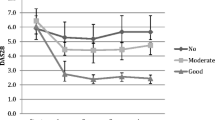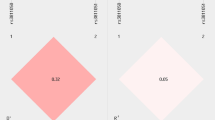Abstract
A variable number of tandem repeats (VNTR) polymorphism has been described in intron 2 of the interleukin-1 receptor antagonist gene. Allele 2 of this polymorphism is associated with many chronic inflammatory diseases. Using direct sequencing of polymerase chain reaction products from individuals of known genotype for the VNTR, we have identified four single base change polymorphisms in exons 1c and 2 and one upstream of exon 1ic all of which are probably in linkage disequilibium with the intron 2 VNTR. The exonic polymorphisms do not alter the encoded amino acid sequence. Using the exon 2 polymorphism as a marker for the intron 2 disease-associated allele, we have been able to analyse allele-specific mRNA in heterozygotic keratinocyte cell lines. The disease-associated allele shows no difference from other alleles in this cell type with respect to mRNA accumulation.
Similar content being viewed by others
References
Arend WP (1993) Interleukin I receptor antagonist. Adv Immunol 54:167–227
Bigler CF, Norris DA, Weston WL, Arend WP (1992) Interleukin 1 receptor antagonist production by human keratinocytes. J Invest Dermatol 98:38–44
Blakemore AIF, Tarlow JK, Cork MJ, Gordon C, Emery P, Duff GW (1994) Interleukin-1 receptor antagonist gene polymorphism as a severity factor in systemic lupus erythematosus. Arthritis Rheum 37:1380–1385
Butcher C, Steinkasserer A, Tejura S, Lennard A (1994) Comparison of two promoters controlling expression of secreted or intracellular IL-1 receptor antagonist. J Immunol 153:701–711
Clay FE, Cork MJ, Tarlow JK, Blakemore AIF, Harrington CI, Lewis F, Duff GW (1994) Interleukin 1 receptor antagonist gene polymorphism association with lichen sclerosus. Hum Genet 94:407–410
Danis VA, Millington M, Hyland VJ, Grennan D (1995) Cytokine production by normal human monocytes: inter-subject variation and relationship to an IL-1 receptor antagonist (IL-Ira) gene polymorphism. Clin Exp Immunol 99:303–310
Haskill JS, Martin G, Van Le L, Morris J, Peace A, Bigler CF, Jaffe GJ, Hammerberg C, Sporn SA, Fong S, Arend WP, Ralph P (1991) cDNA cloning of an intracellular form of the human interleukin 1 receptor antagonist associated with epithelium. Proc Natl Acad Sci USA 88:3681–3685
Lennard A, Gorman P, Carrier M, Griffiths S, Scotney H, Sheer D, Solari R (1992) Cloning and chromosome mapping of the human interleukin 1 receptor antagonist gene. Cytokine 4:83–89
Mandrup-Poulsen T, Pociot F, Molvig J, Shapiro L, Nilsson P, Emdal T, Roder M, Kjems LL, Dinarello CA, Nerup J (1994) Monokine antagonism is reduced in patients with IDDM. Diabetes 43:1242–1247
Mansfield JC, Holden H, Tarlow JK, di Giovine FS, McDowell TL, Wilson AG, Holdsworth CD, Duff GW (1994) Novel genetic association between ulcerative colitis and the anti-inflammatory cytokine interleukin 1 receptor antagonist. Gastroenterology 106:637–642
Nicklin MJH, Weith A, Duff GW (1994) A physical map of the region encompassing the human interleukin-1α, β and the interleukin-1 receptor antagonist genes. Genomics 19:382–384
Tarlow JK, Blakemore AIF, Lennard A, Solari R, Hughes HN, Steinkasserer A, Duff GW (1993) Polymorphism in human IL-1 receptor antagonist gene intron 2 is caused by variable numbers of an 86-bp tandem repeat. Hum Genet 91:403–404
Tarlow JK, Clay FE, Cork MJ, Blakemore AIF, McDonagh AJG, Messenger AG, Duff GW (1994) Severity of alopecia areata is associated with a polymorphism in the interleukin-1 receptor antagonist gene. J Invest Dermatol 103:387–389
Author information
Authors and Affiliations
Rights and permissions
About this article
Cite this article
Clay, F.E., Tarlow, J.K., Cork, M.J. et al. Novel interleukin-1 receptor antagonist exon polymorphisms and their use in allele-specific mRNA assessment. Hum Genet 97, 723–726 (1996). https://doi.org/10.1007/BF02346180
Received:
Revised:
Issue Date:
DOI: https://doi.org/10.1007/BF02346180




